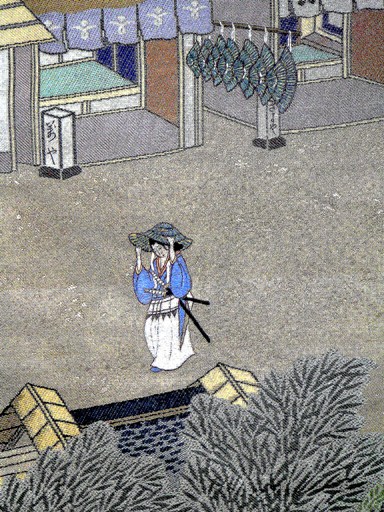Description
(This is the the same weaving house referred to as one of the most prestigious in Memoirs of a Geisha)
This elaborately hand woven Art Work is an example of the difficult art of “finger weaving,” which makes the piece appear to be embroidered; when, in reality, the design is an intricate part of the weaving from its beginning. This is a technique that is far more difficult and involved than embroidering an Obi after it has been woven. This weave is also referred to as “Tsuzure-Ori” or Tapestry weave. The fingernails of the Master Weaver are the basic tools, used along with a wooden comb, with which he beats down the weft of the tapestry. Each nail has a shelf cut in it, which makes it resemble a step ladder…each step holding a different color of silk thread. This enabled the Weaver to create free-form designs; and, also, made it possible for the Weaver to add the Pure Gold background threads which stand out much more boldly than they appear in the photos. In this way, rare and sumptuous designs, resembling hand embroidery, were created for the upper classes. An Obi of this rarity would have taken a Master Weaver a year or more to create.
This elegant Obi was created from natural dyes and hand woven in the Tatsumura Weaving House, located in the famous “Nishijin” weaving center of the textile industry in Kyoto: one of the most prestigious in Kyoto. It was specially designed for a affluent and important woman of a prominent Samurai family. It is difficult to categorize this Obi as it appears to be an exquisite example of the “Maru” Obi, the most formal of the Obi, hand woven of the finest pure Silk and Gold threads. It is an unusual example as it contains two side seams which would ordinarily place it in the Fukuro Obi category; but, because both sides are fully designed, it is much more elaborate than any Fukuro Obi to be handwoven for Japanese women before the turn of the century.
It is, however, the finger weaving and the sophisticated use of pure gold thread woven into the background of the design that makes it absolutely unique. The gold is not only part of the intricacy of the pattern; it also creates an overall sheen to this Obi that is unparalleled.
This is an exquisite example of the most famous of the “Yamato” style of Art dating from the early Meiji Era. It reflects the most refined traits of traditional culture, inculcating the nostalgia for Old Japan. The design places an elite, high standing Samurai warrior, identified by the two swords that he wears, in an unusual village genre scene, while the gold stripes at the bottom of the Obi denote that a woman of high rank and status in Japanese society wore this Obi. Only a member of the nobility, someone with great wealth would have worn such a rich Obi created by the Tatsumura’s.
A Certificate of Authenticity is included.
TTAC will personally pack and ship via UPS at company expense within the continental U.S.








